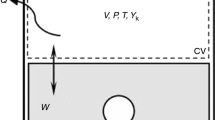Abstract
The research is devoted to the possibility for application of hydrogen accumulated from renewable energy sources as a fuel for a reciprocating engine, which serves as an electrical generator drive. Hydrogen combustion in the chamber of a reciprocating engine, as a rule, occurs in a detonation mode. In order to obtain less hard modes, the present research proposes the usage of steam additions to hydrogen–air mixture or lean hydrogen–air mixtures. Mathematical simulation is used for investigation of combustion of mentioned mixtures in the combustion chamber of a reciprocating engine with a spark-plug ignition. The comparison of the usage of hydrogen–steam–air mixtures and lean hydrogen–air mixtures as fuels is given. The dependence of arising combustion modes and its quantitative characteristics on hydrogen content in combustible composition is investigated. The analysis of optimal combustion is presented, which is based on the consideration of two parameters: peak pressure in one cycle and the crankshaft angle corresponding to the achievement of the peak pressure.
Similar content being viewed by others
References
V. M. Zaichenko, A. D. Tsoi, and A. Ya. Shterenberg, Energy Distributed Production (BuKos, Moscow, 2008) [in Russian].
O. V. Marchenko and S. V. Solomin, “Economic efficiency comparison of hydrogen and electricity production and accumulation,” Izv. Ross. Akad. Nauk, Energ., No. 3, 114–123 (2014).
P. M. Dieguez, J. C. Urroz, S. Marcelino-Sadaba, et al., “Experimental study of the performance and emission characteristics of an adapted commercial four-cylinder spark ignition engine running on hydrogen-methane mixtures,” Appl. Energy 113, 1068–1076 (2014).
S. K. Vudumu and U. O. Koylu, “Computational modeling, validation, and utilization for predicting the performance, combustion and emission characteristics of hydrogen IC engines,” Energy 36, 647–655 (2011).
F. Moreno, J. Arroyo, M. Munoz, and C. Monne, “Combustion analysis of a spark ignition engine fueled with gaseous blends containing hydrogen,” Int. J. Hydrogen Energy 37, 13564–13573 (2012).
A. Mariani, M. V. Prati, A. Unich, and B. Morrone, “Combustion analysis of a spark ignition IC engine fuelled alternatively with natural gas and hydrogen-natural gas blends,” Int. J. Hydrogen Energy 38, 1616–1623 (2013).
R. Z. Kavtaradze, Theory of Piston Engines (Mos. Gos. Tekhn. Univ., Moscow, 2008) [in Russian].
O. M. Belotserkovskii and Yu. M. Davydov, Large-Particle Method in Gas Dynamics (Nauka, Moscow, 1982) [in Russian].
M. A. Liberman, M. F. Ivanov, O. E. Peil, D. M. Valiev, and L.-E. Eriksson, “Numerical modeling of the propagating flame and knock occurrence in spark-ignition engines,” Combust. Sci. Technol. 177, 151–182 (2005).
M. A. Liberman, M. F. Ivanov, O. E. Peil, D. M. Valiev, and L.-E. Eriksson, “Hot spot formation by the propagating flame and the influence of EGR on knock occurrence in SI engines,” Combust. Sci. Technol. 178, 1613–1647 (2006).
M. F. Ivanov, A. D. Kiverin, and M. A. Liberman, “Hydrogen-oxygen flame acceleration and transition to detonation in channels with no-slip walls for a detailed chemical reaction model,” Phys. Rev. E: Statist., Nonlinear, Soft Matter Phys. 83, 056313 (2011).
Thermochemical Database for Combustion Technion. TAE 960 (2005).
J. O. Hirschfelder, Ch. F. Curtiss, and R. B. Bird, Molecular Theory of Gases and Liquids (Wiley, New, York, 1954; InLit., Moscow, 1961).
E. Hairer and G. Vanner, Solving of Ordinary Differential Equations. 2. Stiff and Differential Algebraic Problems, 2nd ed. (Springer-Verlag, Berlin, 1996; Mir, Moscow, 1999).
A. Y. Kusharin, G. L. Agafonov, O. E. Popov, and B. E. Gelfand, “Detonability of H2/CO/CO2/air mixtures,” Combust. Sci. Technol. 135, 85–98 (1998).
A. A. Konnov, Refinement of the kinetic mechanism of hydrogen combustion, Russ. J. Phys. Chem. B 23, 5–18 (2004).
M. O’Conaire, H. J. Curran, J. M. Simmie, et al., “A comprehensive modeling study of hydrogen oxidation,” Int. J. Chem. Kinetics 36, 603–622 (2004).
A. M. Starik, V. E. Kozlov, and N. S. Titova, “On the influence of singlet oxygen molecules on the speed of flame propagation in methane-air mixture,” Combust. Flame 157, 313–327 (2010).
E. Schultz and J. Shepherd, “Validation of detailed reaction mechanisms for detonation simulation,” Technical Report. FM 99-5, 230 (2000).
M. Slack and A. Grillo, “Investigation of hydrogen-air ignition sensitized by nitric oxide and by nitrogen dioxide,” Grumman Research Department Report RE-537, (1977).
R. R. Craig, “A shock tube study of the ignition delay of hydrogen-air mixtures near the second explosion limit,” Report AFAPL-TR-66-74 (1966).
K. A. Bhaskaran, M. C. Gupta, and T. H. Just, “Shock tube study of the effect of unsymmetric dimethyl hydrazine on the ignition characteristics of hydrogen-air mixtures,” Combust. Flame 21, 45–48 (1973).
B. L. Wang, H. Olivier, and H. Gronig, “Ignition of shock-heated H2-air-steam mixtures,” Combust. Flame 133, 93–106 (2003).
B. S. Stechkin, K. I. Genkin, V. S. Zolotarevskii, and I. V. Skorodinskii, Indicator Diagram, Dynamics of Thermovision and Working Cycle of High-Speed FreePiston Engine (Akad. Nauk SSSR, Moscow, 1960) [in Russian].
J. B. Heywood, Internal Combustion Engine Fundamentals (McGraw Hill, New York, 1988).
Author information
Authors and Affiliations
Corresponding author
Additional information
Original Russian Text © A.E. Smygalina, V.M. Zaitchenko, M.F. Ivanov, A.D. Kiverin, 2015, published in Izvestiya Rossiiskoi Akademii Nauk. Energetika.
Rights and permissions
About this article
Cite this article
Smygalina, A.E., Zaitchenko, V.M., Ivanov, M.F. et al. Combustion of hydrogen-based mixtures in gas-fueled reciprocating engines. Therm. Eng. 62, 981–987 (2015). https://doi.org/10.1134/S0040601515130091
Received:
Published:
Issue Date:
DOI: https://doi.org/10.1134/S0040601515130091




